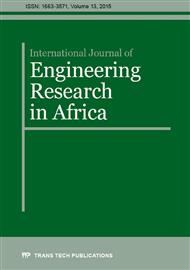[1]
H. Izanloo, A. Mesdaghinia, R. Nabizadeh, K. Naddafi, S. Nasseri, A.H. Mahvi, and S. Nazmara, The Treatment of Wastewater Containing Oil with Aerated Submerged Fixed-Film Reactor. Pak. J. Bio. Sci. 10(17), 2905-2909 (2007).
DOI: 10.3923/pjbs.2007.2905.2909
Google Scholar
[2]
K. Majid, B. Bijan, M. Hossein, M.A. Mohammad, and N. Mahnaz, Biological phosphorus and nitrogen removal from wastewater using moving bed biofilm process. Iranian J. Biotech. 7(1), (2009) 1-9.
Google Scholar
[3]
C.-J.G. Jou, G.-C. Huang, A pilot study for oil refinery wastewater treatment using a fixed-film bioreactor. Advances in Env. Res. 7,463-469 (2002).
DOI: 10.1016/s1093-0191(02)00016-3
Google Scholar
[4]
G. Tchobanoglous, F.L. Burton, and H.D. Tensel, Wastewater Engineering: Treatment and Reuse, 4th edition. MA: McGraw Hill Inc. Boston, 2003.
Google Scholar
[5]
S.J. Arceivala, Wastewater treatment and disposal. Marcel Dekker, New York. p.892, 1981.
Google Scholar
[6]
S.R. Qasim, Wastewater treatment plants. Planning, design, and operation. Holt, Rinehart & Winston, p.726, 1985.
Google Scholar
[7]
M. Von Sperling, Comparison among the most frequently used systems for wastewater treatment in developing countries. Wat. Sci. Tech. 33(3), (1996), 59-72.
DOI: 10.2166/wst.1996.0059
Google Scholar
[8]
V.V. Pushkarev, A.G. Yuzhaninov, and S.K. Men, Treatment of Oil-Containing wastewater; Allerton Press, Inc., New York, 1983.
Google Scholar
[9]
World Bank Group, Pollution prevention Abatement Handbook, p.377, 1998.
Google Scholar
[10]
W. Scholz, W. Fuchs, Treatment of oil-contaminated wastewater in a membrane bioreactor. Water Research. 34(14), 3621-3629, (2000).
DOI: 10.1016/s0043-1354(00)00106-8
Google Scholar
[11]
Y. Yamada, Y. Kawase, Aerobic composing of waste activated sludge: kinetic analysis for microbial reaction and oxygen consumption. Waste Management. 26, (2006), 49–61.
DOI: 10.1016/j.wasman.2005.03.012
Google Scholar
[12]
A. Nemukula, Bacterial treatment of precious metals refinery wastewater. Honours Thesis, Department of Biochemistry, Microbiology and Biotechnology, Rhodes University, Grahamstown, South Africa, 2005.
Google Scholar
[13]
H.A. Gasim, S.R.M. Kutty, and M.H. Isa, Anaerobic treatment of petroleum refinery wastewater. International Conference on Waste Management and Environmental Engineering (ICWMEE), (2012) Kuala Lumpur.
Google Scholar
[14]
H.A. Gasim, S.R.M. Kutty, and M.H. Isa, Treatment of petroleum refinery wastewater using multi-stage biological reactor. Proceeding of International Conference on Civil, Offshore & Environmental Engineering (ICCOEE), (2012) Kuala Lumpur.
Google Scholar
[15]
APHA, Standard methods for the examination of water and wastewater, American Public Health Association Inc., Washington, 1992.
Google Scholar
[16]
M.Amin, S. Kutty, H. Gasim, and M. Isa, Impact of Petroleum Refinery Wastewater on Activated Sludge. The 5th WSEAS International Conference on Environmental and Geological Science and Engineering, (2012). WSEAS, 110-115.
Google Scholar
[17]
E. Vaiopoulou, P. Melidis, A. Aivasidis, An activated sludge treatment plant for integrated removal of carbon, nitrogen and phosphorus. Desalination. 211, (2007), 192–199.
DOI: 10.1016/j.desal.2006.02.092
Google Scholar
[18]
P. Se-Jin, Y. Tai-Il, B. Jae-Ho, S. Hyung-Joon, P. Hyo-Jung, Biological treatment of wastewater containing dimethyl sulphoxide from the semi-conductor industry. Process Biochemistry, 36, (2001), 579–589.
DOI: 10.1016/s0032-9592(00)00252-1
Google Scholar
[19]
X.Y. Li, S.F. Yang. Influence of loosely bound extracellular polymeric substances (EPS) on the flocculation, sedimentation and dewaterability of activated sludge. Water Research. 41(5), (2007), 1022–1030.
DOI: 10.1016/j.watres.2006.06.037
Google Scholar
[20]
A. Ochieng, J.O. Odiyo, M. Mutsago, Biological treatment of mixed industrial wastewaters in a fluidised bed reactor, J Hazard Mater, 96 (2003) 79-90.
DOI: 10.1016/s0304-3894(02)00166-8
Google Scholar
[21]
N.R.A.T. Environment, Environmental Quality Act 1974, in: Environmental Quality (Industrial Effluents) Regulations, Percetakan Nasional Malaysia Berhad, Kuala Lumpur, 2009.
Google Scholar
[22]
L. Metcalf, H. Eddy, Wastewater engineering, treatment, disposal and reuse, McGraw Hill, New York, 2003.
Google Scholar


